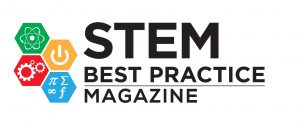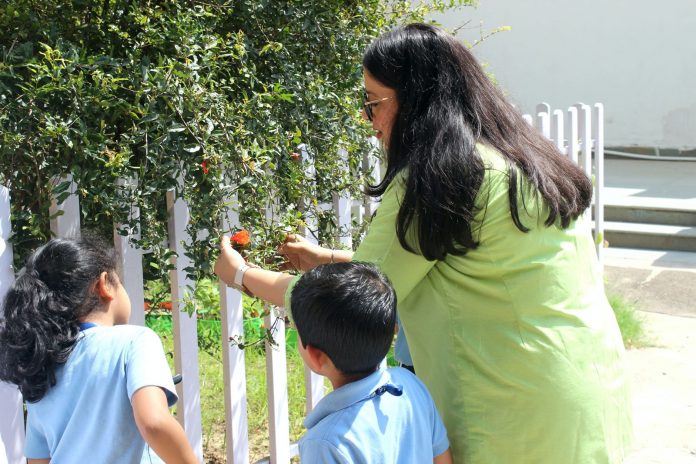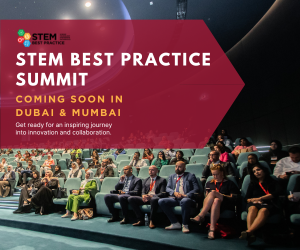There are no bells at our schools. The day begins not with bells, but with the quiet stirrings of a collaborative well-knit vibrant community of learners waking to fresh questions.
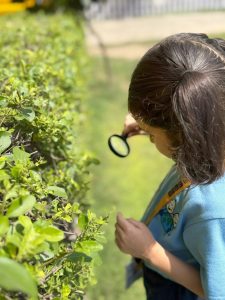 Every morning, children walk into thoughtfully prepared learning environments, some of which are often called ‘classrooms’ in common parlance. Here we have none! What young learners walk into every day at our schools are a whole range of myriad boundless carefully curated thinking spaces, which are simply called ‘learning environments’ / design thinking lounges / creative maker-corridors / collaborative research zones / lego tinkering arenas / independent learning stations / emotional literacy calming nooks / research libraries and laboratories / butterfly gardens / discovery zones / psychomotor gyms / free-play arenas… all prepared with Montessori precision, alive with possibility. Each space—a studio, a garden, an Atelier (in Reggio Emilia format)—is named for the wonder it holds, not the walls that enclose it. Talking of walls, we don’t believe in them much within our school campuses. In these open spaces gazing at infinity, educators are not gatekeepers of knowledge but skilled facilitators who steer curiosity without scripting it; their role is to spark inquiry, to listen deeply, to ignite deeper thinking, to hone creativity and to help each individual learner write their own unique story.
Every morning, children walk into thoughtfully prepared learning environments, some of which are often called ‘classrooms’ in common parlance. Here we have none! What young learners walk into every day at our schools are a whole range of myriad boundless carefully curated thinking spaces, which are simply called ‘learning environments’ / design thinking lounges / creative maker-corridors / collaborative research zones / lego tinkering arenas / independent learning stations / emotional literacy calming nooks / research libraries and laboratories / butterfly gardens / discovery zones / psychomotor gyms / free-play arenas… all prepared with Montessori precision, alive with possibility. Each space—a studio, a garden, an Atelier (in Reggio Emilia format)—is named for the wonder it holds, not the walls that enclose it. Talking of walls, we don’t believe in them much within our school campuses. In these open spaces gazing at infinity, educators are not gatekeepers of knowledge but skilled facilitators who steer curiosity without scripting it; their role is to spark inquiry, to listen deeply, to ignite deeper thinking, to hone creativity and to help each individual learner write their own unique story.
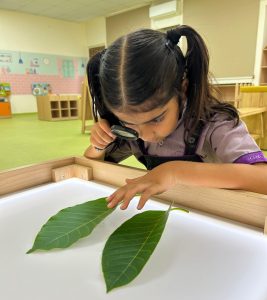
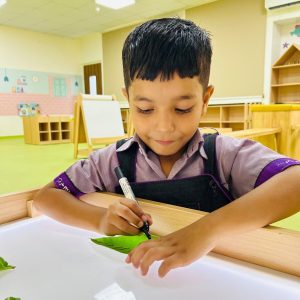
As the sun traces circuits across the sky, students dash between zones designed not by discipline but by the flow of learning itself. A single problem—the architecture of a bench or the secret life of a puddle—pulls at disparate threads of art, technology, innovation, science, research, and mathematics (STREAM rather than STEM). Amidst this patchwork or often a subtle amalgam of blurred subjects lines, learners find their unique rhythm, their questions piling like pebble-stones on a path they themselves pave. The educator moves like a conductor in a room of improvisers, directing the orchestra making music, recognizing when to nudge, when to step back, when to realign, when to draw out, when to let a tune go on for just a bit longer, when to encourage a jugal-bandi amidst debating peers, when to invite reflection. Reflection is not a sidebar but embedded deep into the daily rhythm; it is in quiet moments of pencil-and-paper, in words or doodles, in graphic organisers, in whispered peer discussions, and in the heartbeat pauses before the next wild experiment.
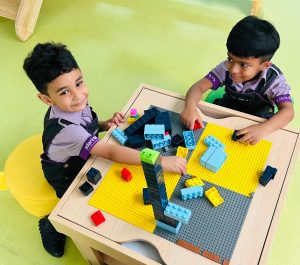
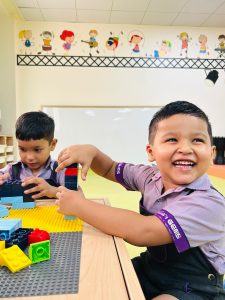
The child’s ownership of their learning is not mere rhetoric. They become not just problem-solvers but creative storytellers—sharing insights, mistakes, and breakthroughs, interpretations of objective, subjective as well as inter-subjective realities with peers and adults alike. This ownership finds its apex in the Student-led Conferences, Empathy Bazaars, Innovation Fairs and much more where children market-stall their learning like a living gallery, each piece a testament to problem, process, the struggle of finding eluding solutions and perseverance. The walls reverberate with more than facts; they vibrate with discovery, resilience, and self-realization. Here, education transcends transmission; it is a collaborative dance of agency, community, and meaning-making, as young learners from Early Years through K-12 transfer their learning with ease to real-life contexts.
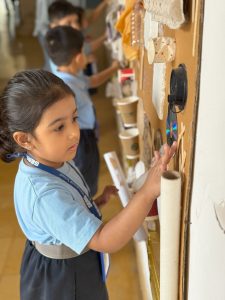 It is in this space that our young learners have managed to develop a walking-path that uses the pressure of foot-steps to generate electricity. This prototype now illuminates a school corridor. This sustainability mindset developed at our schools doesn’t stop with energy literacy. The critical thinkers found a solution to the stubble burning issue as well and now parent engagement sessions are replete with artefacts designed using the stubble in our STREAM labs. Their peers support the solution with apps and logistics designed to help transport the stubble for this reuse. The corridors have furniture designed using plastic waste and this is just a beginning.
It is in this space that our young learners have managed to develop a walking-path that uses the pressure of foot-steps to generate electricity. This prototype now illuminates a school corridor. This sustainability mindset developed at our schools doesn’t stop with energy literacy. The critical thinkers found a solution to the stubble burning issue as well and now parent engagement sessions are replete with artefacts designed using the stubble in our STREAM labs. Their peers support the solution with apps and logistics designed to help transport the stubble for this reuse. The corridors have furniture designed using plastic waste and this is just a beginning.
While our world grapples with the advent of artificial intelligence, our learners comprehend that ‘Life itself is intelligence.’ (quoting Dr Vandana Shiva). They connect with the earth’s intelligence, the intelligence of plants, the intelligence of microbes, of very bacteria in our gut. This intelligence is central to evolution and it celebrates diversity. Our young learners are not just soil literate. They have formed a bond with nature, they are part of the Earth’s healing process. Thus, their vegetable market and herb gardens are sanctums of serenity.
This beautiful journey of learners is made possible by educators who engage each day in a labour of love. Each day is filled with rigorous reflection, dissecting moments of confusion and clarity, and constantly adapting to the evolving needs of the learners before them. They embody the ethos that every question posed by a child is also an invitation to grow. Professional learning here is collective and never static or top-down. Educator’s own learning is also a dynamic spiral of inquiry that mirrors their students’ journeys.
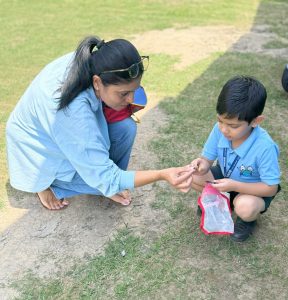 To wander through these learning environments is to witness a future unimagined by conventional school designs. It is a world where the child leads, adults follow, and learning refuses to be confined by age, subject, or expectation. The future is not a distant dream but a breath of fresh air with every small discovery, every shared story, every dirt-stained hand reaching to seek knowledge, curious to learn. This is education unboxed, unbound, and utterly alive, readying young minds not to survive the storm but to dance on its heart-beat.
To wander through these learning environments is to witness a future unimagined by conventional school designs. It is a world where the child leads, adults follow, and learning refuses to be confined by age, subject, or expectation. The future is not a distant dream but a breath of fresh air with every small discovery, every shared story, every dirt-stained hand reaching to seek knowledge, curious to learn. This is education unboxed, unbound, and utterly alive, readying young minds not to survive the storm but to dance on its heart-beat.
About the Author
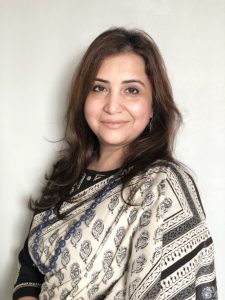
With over 30 years of transformative work in education, Dr Amrita Vohra is a passionate educator, currently leading academic operations for all projects at Adani GEMS Education as Head of Education.
A PhD in English Literature, a certified Program Leader for Cambridge Professional Development Qualifications for teachers and school leaders, a certified IB Head of School and Cambridge TKT qualified educator, Dr Amrita has been recognized as one of India’s top 100 ‘Great People Managers’. Known for embedding ‘Cultures of Thinking’ at schools, she has served as COO & Director Education – India for GEMS Education and led various schools as Principal. She has mentored a lot of green and brownfield school projects across India with National, Cambridge and IB curricula. Education Policy, School Leadership Development, Quality Assurance, Capacity Building, Early Childhood Education, Drama-in-Education, Inclusive Education and Social-Emotional Learning are some of her key interests. She is recognized as an expert on Teaching of English and Reading Programs and has contributed to numerous standard-setting exercises, capacity building workshops, leadership development and academic research initiatives by ACER (Australian Council for Education Research), OUP (Oxford University Press), CBSE and others. From Workshops for DIET Principals in Kerala to affordable and premium private schools spread across India, to developing curricula, leading school quality assurance audits, to supporting and establishing schools, she has been working relentlessly to improve education quality across the spectrum, with her transformative ideas. Her personal blog www.pindropsilence.in is widely appreciated among educators. A Bharatnatyam dancer and theatre professional, she is a creative artist at heart.

